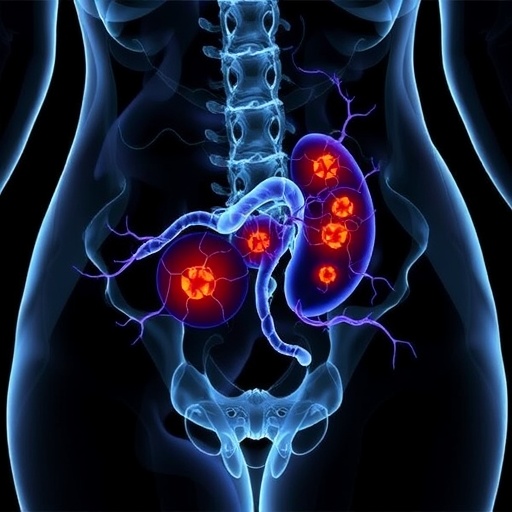In a groundbreaking advancement poised to transform regenerative medicine and women’s health, researchers have unveiled a novel therapeutic target that holds promise for preventing and treating uterine scarring, a debilitating condition that disrupts fertility and significantly impairs reproductive outcomes. This study, recently published in Nature Communications, meticulously identifies the critical role of a protein known as secreted frizzled-related protein 2 (sFRP2), which is derived from fibroblasts in the uterine environment. Unlocking the molecular intricacies of sFRP2’s function has enabled scientists to engineer a sophisticated small interfering RNA (siRNA) therapy aimed at modulating its expression, thereby opening new avenues for clinical intervention in uterine fibrosis.
Uterine scarring, or intrauterine adhesions, represent a pathological aftermath of trauma, infection, or surgical procedures that damage the delicate endometrial tissue lining the uterus. These adhesions often lead to infertility, recurrent pregnancy loss, and menstrual irregularities, conditions that have long challenged gynecologists due to limited therapeutic options. The intricate cellular and molecular mechanisms driving fibrosis in the uterine matrix have remained elusive until now, hindering the development of targeted treatments. The identification of sFRP2 as a pivotal mediator unveils a hitherto unexplored facet of fibrotic signaling within the uterine stroma.
The investigative team, led by Cheng, Zhang, and Gui, undertook an interdisciplinary approach combining molecular biology, bioinformatics, and in vivo experimentation to characterize the expression profile and functional relevance of sFRP2 in fibrotic uterine tissue. Their data cogently demonstrated an upregulation of sFRP2 in fibroblast populations isolated from scarred uterine samples compared to healthy controls. This protein, known to modulate Wnt signaling pathways, was found to orchestrate pro-fibrotic responses, promoting extracellular matrix deposition and fibroblast proliferation—key hallmarks of scar formation.
.adsslot_kAxnt2413K{ width:728px !important; height:90px !important; }
@media (max-width:1199px) { .adsslot_kAxnt2413K{ width:468px !important; height:60px !important; } }
@media (max-width:767px) { .adsslot_kAxnt2413K{ width:320px !important; height:50px !important; } }
ADVERTISEMENT
Crucially, the researchers engineered a tailored siRNA-based therapeutic designed to specifically silence sFRP2 expression in uterine fibroblasts, harnessing the precision of RNA interference technology. The siRNA molecules were encapsulated within a biocompatible nanocarrier, ensuring targeted delivery and sustained release at the site of injury. In preclinical models of uterine fibrosis, administration of this siRNA therapy resulted in a marked reduction in scar tissue formation, restoring normal tissue architecture and improving functional parameters associated with fertility.
The innovation lies not only in the identification of sFRP2 as a modifiable molecular target but also in the sophisticated design of the siRNA delivery system. Nanoparticle-mediated delivery systems circumvent the challenges of nuclease degradation and off-target effects, enabling robust uptake by uterine fibroblasts while minimizing systemic exposure. This nuanced approach underscores the potential for localized therapy that mitigates fibrosis without eliciting adverse immune responses or compromising other uterine functions.
Mechanistically, the study elucidates the pathway by which sFRP2 amplifies fibrotic signaling. By binding and modulating Wnt ligands, sFRP2 alters downstream signaling cascades, including β-catenin-dependent transcription, which is integral to fibroblast activation and extracellular matrix production. The suppression of sFRP2 interrupts these signaling loops, thereby attenuating aberrant fibrogenesis. This discovery not only redefines the molecular underpinnings of uterine scarring but also highlights the versatility of Wnt pathway modulators as therapeutic targets in fibrotic diseases.
The clinical implications of this research extend beyond the realm of uterine pathology. Fibrosis is a pervasive feature across numerous organ systems, including the liver, lung, and heart, causing progressive dysfunction and morbidity. By establishing sFRP2 as a central node in fibrotic signaling, the findings catalyze potential cross-applications of siRNA therapeutic strategies for other intractable fibrotic conditions. Moreover, the study exemplifies how precision medicine approaches leveraging genetic and molecular insights can yield bespoke therapies poised to revolutionize patient outcomes.
In addressing the challenges of delivery and specificity, the researchers employed state-of-the-art nanotechnology platforms. These platforms incorporated targeting ligands that recognize fibroblast surface markers, ensuring selective uptake. The controlled release kinetics facilitated by the nanocarriers optimized therapeutic windows while reducing dosing frequency, an important consideration for patient compliance and clinical feasibility. These technological refinements epitomize the convergence of molecular biology and nanomedicine in crafting next-generation therapeutics.
From a translational perspective, this research paves the way for developing minimally invasive delivery modalities, such as intrauterine devices or catheter-based systems, capable of local siRNA administration. Such approaches could be integrated into surgical protocols for uterine procedures, proactively mitigating scarring complications. The potential for personalized dosage adjustments, guided by biomarkers of fibrosis progression, could further tailor treatment regimens to individual patient needs, embodying the principles of precision gynecology.
The discovery of sFRP2’s role in uterine fibrosis also prompts a reevaluation of existing therapeutic paradigms. Current treatments often involve surgical intervention or hormonal therapies, which can be insufficient or associated with significant side effects. The biochemical targeting of sFRP2 offers a non-hormonal, mechanistically grounded alternative, likely to improve efficacy and reduce long-term sequelae. This could significantly enhance quality of life and reproductive outcomes for affected women worldwide.
Furthermore, the study’s rigorous experimental design included transcriptomic analyses, providing a comprehensive map of gene expression changes upon sFRP2 inhibition. This systems biology approach illuminated downstream effectors and regulatory circuits, offering a broader understanding of fibrosis resolution processes. Such insights may assist in identifying synergistic therapeutic targets, potentially augmenting the efficacy of siRNA monotherapy through combination regimens.
Looking beyond the immediate therapeutic horizon, this research exemplifies the power of integrating advanced genomic tools with cutting-edge drug delivery technologies. By bridging molecular insights with clinical innovation, it sets a benchmark for future endeavors aimed at combating fibrotic diseases—a class of disorders often neglected in drug development due to their complex pathophysiology.
Ultimately, this pioneering research not only advances our understanding of fibroblast biology and fibrogenesis but also heralds a new era of targeted molecular therapies for uterine disorders. The translational journey from bench to bedside, while requiring further clinical validation, is now firmly on the horizon, driven by the precision and efficacy demonstrated in this seminal study.
As the scientific community embraces these findings, the ripple effects are likely to inspire analogous investigations into other fibrotic diseases where sFRP2 or related pathways play pathogenic roles. The confluence of molecular targeting and nanotechnology-driven delivery systems represents an exciting frontier in medicine, one where diseases once deemed intractable become amenable to finely tuned genetic interventions.
This innovative therapeutic strategy, centering on fibroblast-derived sFRP2 and siRNA-based inhibition, epitomizes the future of personalized medicine in reproductive health. It underscores the potential of leveraging endogenous molecular players as leverage points for disrupting pathological processes, reshaping the landscape of fertility preservation and regenerative therapy.
Subject of Research: Fibroblast-derived secreted frizzled-related protein 2 (sFRP2) as a therapeutic target in uterine scarring and the development of siRNA therapy to inhibit its function.
Article Title: Identifying fibroblast-derived sFRP2 as a therapeutic target and engineering siRNA therapy for uterine scarring.
Article References:
Cheng, J., Zhang, S., Gui, Q. et al. Identifying fibroblast-derived sFRP2 as a therapeutic target and engineering siRNA therapy for uterine scarring. Nat Commun 16, 6850 (2025). https://doi.org/10.1038/s41467-025-62248-1
Image Credits: AI Generated
Tags: fibroblast-derived therapeutic targetsimplications of sFRP2 in reproductive outcomesintrauterine adhesions and infertilitymolecular mechanisms of uterine scarringnovel interventions in gynecologyovercoming trauma-induced uterine damageregenerative medicine advancements for women’s healthsecreted frizzled-related protein researchsFRP2 protein in reproductive healthsiRNA therapy for uterine scarringtargeted therapies for endometrial tissue repairuterine fibrosis treatment options





